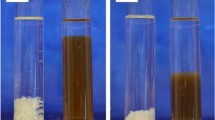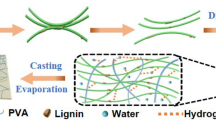Abstract
Two lignocellulosic nanofibrils (LCNF) were produced from celery using oxalic acid hydrolysis and sonication (OS) or refining by a SuperMassColloider grinder treatment (MT). Physicochemical properties, such as morphological properties, crystallinity, thermal stability, zeta potential and transmittance for the obtained nanofibrils were evaluated. Compared to refining in SuperMassColloider grinder, OS treatment contributed greater separation of nanofibril bundles by introducing negative carboxyl groups. In detail, mechanical fibrillation resulted in the LCNF with longer length and thicker diameter. OS treatment produced LCNF with smaller height of 5.5 nm and higher aspect ratio than the one obtained by MT treatment, and endowed high crystallinity and thermal stability due to its preferential degradation of amorphous carbohydrates and lignin. Furthermore, OS-LCNF with carboxyl group contributed more stable aqueous suspension with surface charge of − 32.9 mV, better than MT-LCNF sample with entangled network structure. The comparative study can gain insight into the use of celery as a potential source for nanocellulose production.







Similar content being viewed by others
References
Alemdar A, Sain M (2008) Isolation and characterization of nanofibers from agricultural residues—wheat straw and soy hulls. Bioresour Technol 99:1664–1671
Bian H, Chen L, Dai HQ et al (2017a) Effect of fiber drying on properties of lignin containing cellulose nanocrystals and nanofibrils produced through maleic acid hydrolysis. Cellulose 24:4205–4216
Bian H, Chen LH, Gleisner R et al (2017b) Producing wood-based nanomaterials by rapid fractionation of wood at 80 °C using a recyclable acid hydrotrope. Green Chem 19:3370–3379
Bian H, Gao Y, Yang Y et al (2018) Improving cellulose nanofibrillation of waste wheat straw using the combined methods of prewashing, p-toluenesulfonic acid hydrolysis, disk grinding, and endoglucanase post-treatment. Bioresour Technol 256:321–327
Cao Y, Tan H (2005) Study on crystal structures of enzyme-hydrolyzed cellulosic materials by X-ray diffraction. Enzyme Microb Technol 36:314–317
Chen L, Zhu JY, Baez C et al (2016) Highly thermal-stable and functional cellulose nanocrystals and nanofibrils produced using fully recyclable organic acids. Green Chem 18:3835–3843
Cherian BM, Pothan LA, Nguyen-Chung T et al (2008) A novel method for the synthesis of cellulose nanofibril whiskers from banana fibers and characterization. J Agric Food Chem 56:5617–5627
Costa ALR, Gomes A, Tibolla H et al (2018) Cellulose nanofibers from banana peels as a Pickering emulsifier: high-energy emulsification processes. Carbohydr Polym 194:122–131
Espinosa E, Tarrés Q, Delgado-Aguilar M et al (2016) Suitability of wheat straw semichemical pulp for the fabrication of lignocellulosic nanofibres and their application to papermaking slurries. Cellulose 23:837–852
Ferrer A, Quintana E, Filpponen I et al (2012) Effect of residual lignin and heteropolysaccharides in nanofibrillar cellulose and nanopaper from wood fibers. Cellulose 19:2179–2193
French AD (2014) Idealized powder diffraction patterns for cellulose polymorphs. Cellulose 21:885–896
French AD, Santiago Cintrón M (2013) Cellulose polymorphy, crystallite size, and the Segal Crystallinity Index. Cellulose 20:583–588
Heinze T, Liebert T (2001) Unconventional methods in cellulose functionalization. Prog Polym Sci 26:1689–1762
Hirai A, Inui O, Horii F et al (2009) Phase separation behavior in aqueous suspensions of bacterial cellulose nanocrystals prepared by sulfuric acid treatment. Langmuir 25:497–502
Huang J, Zhu H, Chen Y et al (2013) Highly transparent and flexible nanopaper transistors. ACS Nano 7:2106–2113
Jin W, Singh K, Zondlo J (2013) Pyrolysis kinetics of physical components of wood and wood-polymers using isoconversion Method. Agriculture 3:12–32
Li MC, Wu Q, Song K et al (2015) Cellulose nanoparticles: structure-morphology-rheology relationship. ACS Sustain Chem Eng 3:821–832
Li MY, Hou XL, Wang F et al (2018) Advances in the research of celery, an important Apiaceae vegetable crop. Crit Rev Biotechnol 38:1–12
Nechyporchuk O, Belgacem MN, Bras J (2016) Production of cellulose nanofibrils: a review of recent advances. Ind Crops Prod 93:2–25
Poletto M, Zattera AJ, Forte MMC, Santana RMC (2012) Thermal decomposition of wood: influence of wood components and cellulose crystallite size. Bioresour Technol 109:148–153
Raveendran K, Ganesh A, Khilar KC (1996) Pyrolysis characteristics of biomass and biomass components. Fuel 75:987–998
Robles-García MÁ, Del-Toro-Sánchez CL, Márquez-Ríos E et al (2018) Nanofibers of cellulose bagasse from Agave tequilana Weber var. azul by electrospinning: preparation and characterization. Carbohydr Polym 192:69–74
Rojo E, Peresin MS, Sampson WW et al (2015) Comprehensive elucidation of the effect of residual lignin on the physical, barrier, mechanical and surface properties of nanocellulose films. Green Chem 17:1853–1866
Sluiter A, Hames B, Ruiz R et al (2010) Determination of structural carbohydrates and lignin in biomass determination of structural carbohydrates and lignin in biomass. Natl Renew Energy Lab
Spence KL, Venditti RA, Rojas OJ et al (2010) The effect of chemical composition on microfibrillar cellulose films from wood pulps: water interactions and physical properties for packaging applications. Cellulose 17:835–848
Tarrés Q, Ehman NV, Vallejos ME et al (2017) Lignocellulosic nanofibers from triticale straw: the influence of hemicelluloses and lignin in their production and properties. Carbohydr Polym 163:20–27
Tripathi A, Ferrer A, Khan SA, Rojas OJ (2017) Morphological and thermochemical changes upon autohydrolysis and microemulsion treatments of coir and empty fruit bunch residual biomass to isolate lignin-rich micro- and nanofibrillar cellulose. ACS Sustain Chem Eng 5:2483–2492
Yang H, Yan R, Chen H et al (2007) Characteristics of hemicellulose, cellulose and lignin pyrolysis. Fuel 86:1781–1788
Yu H, Yan C, Lei X et al (2014) Novel approach to extract thermally stable cellulose nanospheres with high yield. Mater Lett 131:12–15
Acknowledgments
The research was supported by the National Natural Science Foundation of China (31370573). Also, the authors gratefully acknowledge financial support from the Priority Academic Program Development of Jiangsu Higher Education Institutions (PAPD).
Author information
Authors and Affiliations
Corresponding author
Additional information
Publisher's Note
Springer Nature remains neutral with regard to jurisdictional claims in published maps and institutional affiliations.
Rights and permissions
About this article
Cite this article
Luo, J., Huang, K., Xu, Y. et al. A comparative study of lignocellulosic nanofibrils isolated from celery using oxalic acid hydrolysis followed by sonication and mechanical fibrillation. Cellulose 26, 5237–5246 (2019). https://doi.org/10.1007/s10570-019-02454-5
Received:
Accepted:
Published:
Issue Date:
DOI: https://doi.org/10.1007/s10570-019-02454-5




